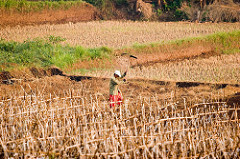
This year’s World Food Day theme – Change the future of migration. Invest in food security and rural development – highlights the challenges brought about in a world where more and more people are on the move, seeking political stability and better circumstances. With this putting an increased strain on available resources, it is essential that strategies be put into place to address rural development and the creation of favorable conditions to retain populations.
Sub-Saharan Africa
Food security is defined as ‘the state of having reliable access to a sufficient quantity of affordable, nutritious food.’ In sub-Saharan Africa, there are many examples of food insecurity and some of them have reached catastrophic levels, having also been affected by severe floods and droughts. Since 1990, the number of stunted children in sub-Saharan Africa has increased by 33% even though it has fallen in all other world regions.

Food insecurity is not just about insufficient food production, availability, and intake, but is also about the poor quality or nutritional value of the food. While, for example, most staple foods such as cereals, tubers and pulses are rich in Vitamin C, they have very low concentrations of iron, Vitamin A and zinc. A study published recently in BMC Public Health uses the proportion of household food spending on staples to explain stunting and wasting among children aged 5 years or less in Uganda, a country with a wide variety of staple foods. The researchers find that a greater proportion of less nutritious staple foods is associated with both wasting and stunting.
United States
It may come as a surprise but food insecurity is a growing public health concern in the United States. American Indian families are particularly vulnerable as they have limited access to healthy foods and higher levels of poverty.
Considering that no studies to date have examined the relationship between household food insecurity and dietary intake in American Indian adults or in very young American Indian children, the authors of a publication in BMC Public Health sought to determine the prevalence of food insecurity in American Indian households and its correlates. They identify an extremely high prevalence of food insecurity among the American Indian households included in their study, with the proportion of households self-reporting food insecurity significantly different between rural and urban households. Their analysis also suggests that identification as American Indian, urban households, lower educational levels, single adult households, and participation in ‘Special Supplemental Nutrition Program for Women, Infants, and Children ‘ are factors that are associated with the increased odds for being food insecure.
Food insecurity and obesity: a public health paradox
As unlikely as it may sound, food insecure children are more likely to be obese. Healthful and affordable food options in low-income neighborhoods or countries can be hard to come across, meaning that parents opt for food which is cheap but not necessarily nutritious.

A study published in BMC Public Health measures socioeconomic correlates of household food insecurity and explores its association with dietary intake and odds of obesity among mothers in Lebanon, a middle-income country undergoing nutrition transition. It reports that a high household food insecurity prevalence exists among urban Lebanese households and that mothers from these households have a high risk of dietary inadequacy and obesity.
Improving low-income areas access to affordable foods would be a significant step towards healthier communities but this is challenging. Programs need to be developed at local and national levels to increase the dietary quality and diversity of foods consumed by at-risk populations through promoting the consumption of affordable nutrient-dense foods including fruits, vegetables, and protein-rich foods, and lowering the intake of added sugars and refined grains. School-related policies which provide nutritious meals to children who are otherwise not receiving these at home provides an example of a good starting point.
If you are carrying out research on food security, food choice or nutrition, why not submit you work to BMC Public Health? Do not hesitate to contact us if you would like to ask about the suitability of your manuscript to the journal.
Comments